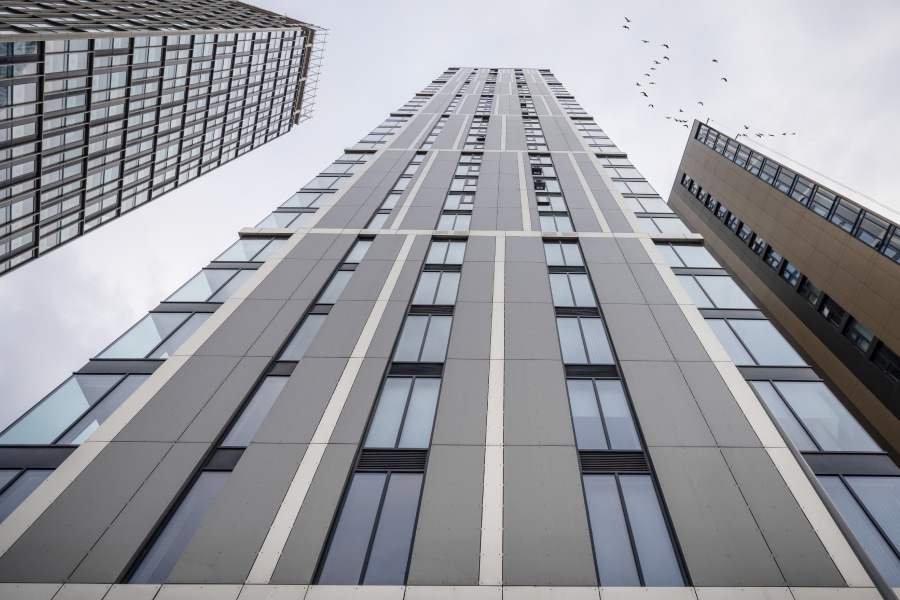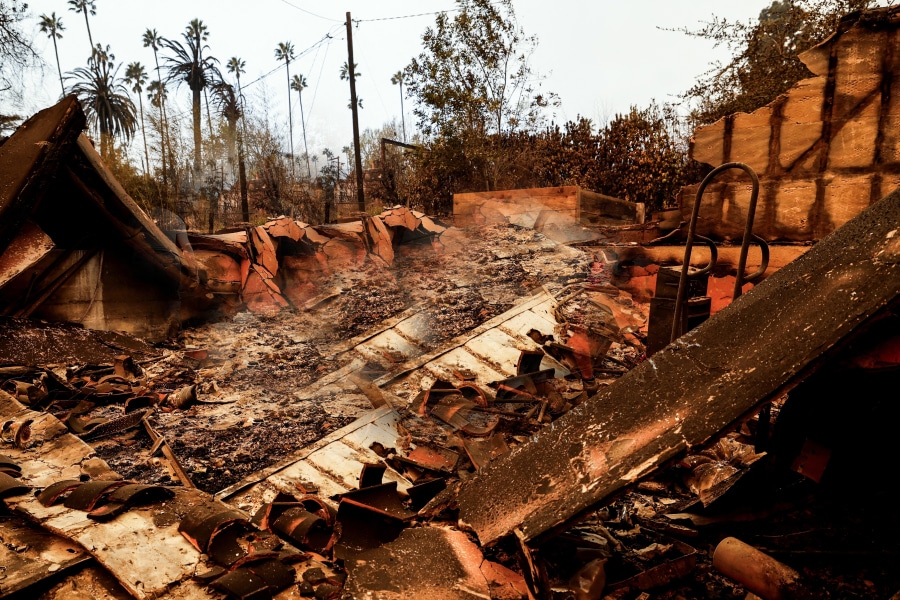Birds see things differently—and that’s a deadly problem for them.
When they’re flying toward a window, they see food, trees and skies, not a reflection. The next instant often brings a gut-wrenching thud and a stunned bird or carcass on the ground. But humans seldom see or hear this, making it seem like these strikes are rare, limited to when migration paths cross skyscrapers, easily solved by pasting a sticker on a window.
These are myths, according to Brendon Samuels, a doctoral student at the University of Western Ontario and expert in how birds perceive the world. An estimated 400 million to 1 billion birds strike buildings and die each year in the United States and Canada. Some 44% to 90% of deaths occur at low-rise residential structures, and birds fly around those colorful stickers and aim for the clear spaces that surround them.
One point is crucial: The amount of glass on a building—especially clear or mirrored—is the best predictor of the number of birds that will die running into it.
“We can’t change the bird, so we must change the building,” Samuels said. That takes a willingness to modify the structures so they don’t contribute to the 30% drop in bird numbers that Cornell Lab has seen since the 1970s. To save avians, architects, engineers and planners need to incorporate bird-friendly design in every project, while bird advocates, government authorities and legislators strive to implement model ordinances and bird-safe building codes.
The scourge of bird strikes
If no one sees or hears a bird run into a window, it goes unnoticed except by the bird suffering from hemorrhage, concussion or damage to its bill, skull, eyes or wings. But during the COVID-19 pandemic—when millions around the globe teleworked—the Google search volume for “bird window” skyrocketed, indicating this “infrequent” event became much more observable, especially at home.
“There’s very little uptake of bird-safe design in residential building construction,” Samuels said. “It’s almost entirely voluntary adoption by homeowners and renters who treat their windows.” If the treatment is stickers—or raptor and crow calls or plastic owls—it’s largely ineffective.
One more confounding factor is artificial lighting at night that disorients birds, compelling some to circle until dawn. The Audubon Lights Out Program offers an immediate solution by encouraging building owners and managers to turn off excess lighting during months when birds are migrating.
Bird-aware building design
The first step architects and designers can take to protect birds is determining what ordinances or building codes apply. To assess the risk a specific structure might pose, Fatal Light Awareness Program (FLAP) Canada developed the BirdSafe® DIY Building Risk Assessment to estimate the collision risks—both day and night—that a building and its individual façades present.
Bird-safe building design standards help alleviate that risk, Samuels said. The American Bird Conservancy (ABC) offers an in-depth Bird-Friendly Building Design guide that covers underlying science and solutions for new and existing buildings. Although LEED adopted a permanent “Bird Collision Deterrence” credit in 2022, it isn’t mandatory—so even all LEED-rated buildings aren’t bird-friendly.
Expertise is also critical. “Start with a professional, because design is not one-size-fits-all,” said Heidi Trudell, bird friendly specialist, regional technical advisor, Guardian Glass. “You may need to triage solutions or use multiple products to fine-tune for your situation.”
For a new structure, Trudell recommended incorporating bird-friendly design and products as early as possible for greater control over aesthetics, thermal benefits, cost and effectiveness. On the other hand, retrofit solutions have a limited lifespan compared to glass, with labor for installing solutions like films making up the bulk of the cost. But after-the-fact treatments may be the only option for residences, because most bird-friendly glass comes in 6” commercial thicknesses, not the 4” thickness that residential framing supports.
A close-up look at glass
The goal for glass is incorporating a visual element that birds detect, react to and avoid by diverting their path. Three bird-friendly categories of glass products are available—frit, etch and UV. For all these categories, patterns and visual interest should appear on S1 (the outermost layer of glass) to increase effectiveness, Trudell said. Any low-e coating can be used on S2 or S3 as needed to meet thermal performance goals. Bright white ceramic frit provides the best contrast, critical to ensure birds can see the patterns against the interior background.
Bird-safe glass can also lead to a win-win for thermal efficiency and aesthetics. “In cases where a frit pattern is planned for the glazing, slightly modifying the proposed pattern’s size and spacing to provide bird deterrence may have a minimal impact on cost while still meeting the required design and energy performance required,” Trudell said.
The tight arrangement of stripes and dots needed to stop birds can surprise designers. “The recommended spacing is usually 5 centimeters or 2 inches between markers,” Samuels noted. “Applications must cover the entire surface and not leave gaps too much wider than the bird.” Designers can gain inspiration from successful installations that use certified products, like those included in the ABC Products & Solutions Database.
Convergence of code and products
With more effective solutions coming on the market, municipalities can enact ordinances and implement building codes to enforce bird-safe design. Toronto was the first city worldwide to update local bylaws and adopt bird-friendly building design into regulation. Now others are following suit. In 2020, New York City passed legislation requiring bird-friendly materials on the outside of new buildings and alterations replacing all exterior glazing.
Elsewhere, concerned citizens are working to develop and pass ordinances requiring adoption of bird-friendly building standards. For example, American Bird Conservancy has a model bird-friendly building ordinance that municipalities, states, universities and businesses can use as a starting point. Ordinances should apply to as many building types as possible, not just skyscrapers, and incorporate the need for retrofits to reduce bird collisions.
The U.S. government intends to lead by example. The Bipartisan Bird Safe Buildings Act focuses on reducing bird impacts with federal buildings—and hopefully that will raise awareness of building strategies to protect birds and offer guidance that can keep the world’s feathered creatures alive.













